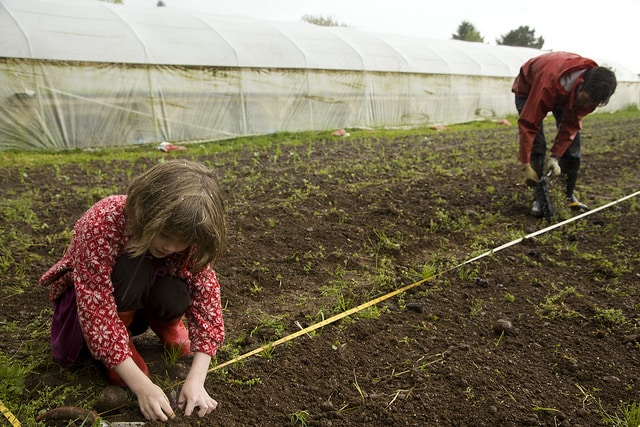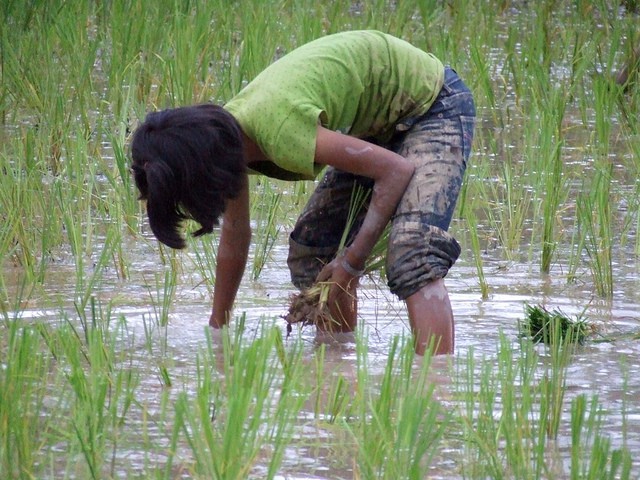Sustainable farming or, in a broader term, Sustainable agriculture is using farming practices considering the ecological cycles. It is also sensitive towards the microorganisms and their equations with the environment at large. In simpler terms, sustainable farming is farming ecologically by promoting methods and practices that are economically viable, environmentally sound and protect public health.
It does not only concentrate on the economic aspect of farming, but also on the use of non-renewable factors in the process thoughtfully and effectively. This contributes to the growth of nutritious and healthy food as well as brings up the standard of living of the farmer.
Our environment, and subsequently, our ecology have become an area of concern for us over the last few decades. This has increasingly led us to contemplate, innovate and employ alternate methods or smaller initiatives to save our ecology.
One such initiative is sustainable farming. It simply means the production of food, plants and animal products using farming techniques that prove to be beneficial for public health and promote economic profitability. It draws and learns from organic farming.
Sustainable farming or Sustainable agriculture helps the farmers innovate and employ recycling methods, apart from the conventional perks of farming. A very good example of recycling in sustainable farming would be crop waste or animal manure. The same can be transformed into fertilizers that can help enrich the soil.
Another method that can be employed is crop rotation. This helps the soil maintain its nutrients and keeps the soil rich and potent. Collection of rainwater via channeling and then its utilization for irrigation is also a good example of sustainable farming practices.
Benefits of Sustainable Farming
1. Environment Preservation
2. Economic Profitability
3. Most efficient use of non-renewable resources
4. Protection of Public Health
5. Social and Economic Equity
Sustainable Farming Methods or Practices
Let us see various methods or practices of Sustainable Farming in detail:
1. Make use of Renewable Energy Sources
The first and most important practice is the use of alternate sources of energy. The use of solar, hydro-power or wind-farms is ecology friendly. Farmers can use solar panels to store solar energy and use it for electrical fencing and running of pumps and heaters.
Running river water can be a source of hydroelectric power and can be used to run various machines on farms. Similarly, farmers can use geothermal heat pumps to dig beneath the earth and can take advantage of earth’s heat.
2. Integrated pest management
Integrated pest management is a combination of pest control techniques for identifying and observing pests in the initial stages. One also needs to realize that not all pests are harmful, and therefore it makes more sense to let them co-exist with the crop than spend money eliminating them.
Targeted spraying works best when one need to remove specific pests only. This not only helps you to spray pest on the selected areas but will also protect wildlife from getting affected.
3. Hydroponics and Aquaponics
In these innovative farming techniques, plants grow without soil and get nourished through specialized nutrients that are added to water.
In hydroponic systems, crops are grown with the roots directly in a mineral solution or with the roots in an inert medium like gravel or perlite. Aquaponics combines the raising of aquatic animals (such as fish) with the growing of hydroponic crops.
The water containing nutrients resulting from the mineralization of the waste material from the aquaculture fish is used to nourish the hydroponic plants. After the plants use the water, the water gets purified and then re-circulated back into the system to be reused by the fish.
Both hydroponic and aquaponic systems are available in a variety of scales, from small home-scale systems to commercial-scale systems.
4. Crop Rotation
Crop rotation is a tried and tested method used since ancient farming practices proven to keep the soil healthy and nutritious. Crop rotation has a logical explanation to it – the crops are picked in a pattern so that the crops planted this season replenish the nutrients and salts from the soil that were absorbed by the previous crop cycle. For example, row crops are planted after grains to balance the used nutrients.
5. Polyculture Farming
It involves growing multiple crop species in one area. These species often complement each other, and greater diversity of products can be produced at one plot while fully utilizing available resources. High biodiversity makes the system more resilient to weather fluctuations, promotes a balanced diet and applies natural mechanisms for preservation of soil fertility.
6. Permaculture
Permaculture is a food production system with intention, design, and smart farming to reduce waste of resources and create increased production efficiency. The focus is on the use of perennial crops such as fruit trees, nut trees, and shrubs that all function together in a designed system that mimics how plants in a natural ecosystem would function.
Permaculture design techniques include growing grain without tillage, herb and plant spirals, hugelkultur garden beds, keyhole and mandala gardens, sheet mulching, each plant serving multiple purposes, and creating swales on contour to hold water high on the landscape.
7. Avoid Soil Erosion
Healthy soil is key to a good crop. Age-old techniques like tilling the land, plowing etc. still work wonders. Manure, fertilizers, cover crops etc. also help improve soil quality. Crop rotations prevent the occurrence of diseases in crops, as per studies conducted.
Diseases such as crown rot and tan spot can be controlled. Also, pests like septoria, phoma, etc. can be eliminated by crop rotation techniques. Since diseases are crop-specific, crop rotation can work wonders.
8. Crop Diversity
Farmers can grow varieties of the same crop yielding small but substantial differences among the plants. This eases financial burdening. This process is called crop diversity, and its practical use is on a downslide.
9. Agroforestry
Agroforestry has become one of the powerful tools of farmers in dry regions with soils susceptible to desertification. It involves the growth of trees and shrubs amongst crops or grazing land, combining both agriculture and forestry practices for long-lasting, productive, and diverse land use when approached sustainably.
Trees here create a favorable microclimate that maintains the favorable temperature and soil humidity while protecting crops from wind or heavy rain. Trees have another important role. They stabilize soils, minimize nutrient runoff and improve soil structure.
Trees in this farming system also provide wood and fruits as an additional source of income for farmers with the possibilities for product diversification. Farmers can go even as far as growing a whole edible forest.
10. Food Forests
Food forests (also known as “forest gardens”) are based on natural forest ecosystems and designed permaculture systems that consist of a multilayered edible “forest.” These food forests are composed almost entirely of perennial food plants, including a canopy of tall and dwarf fruit and nut trees, a fruit shrub layer, layers of perennial herbs, mushrooms and vegetables at the ground level, climbing plants, and root vegetables underground.
Food forest systems are very productive because of both the diversity of plants that are growing there and all the plants are take advantage of each existing niche within the system.
11. Natural Pest Eliminators
Bats, birds, insects etc. work as natural pest eliminators. Farmers build a shelter to keep these eliminators close. Ladybugs, beetles, green lacewing larvae, and fly parasites all feed on pests, including aphids, mites and pest flies.
These pest eliminators are available in bulk from pest control stores or farming supply shops. Farmers can buy and release them on or around the crops and let them make the farm as their home.
12. Biodynamic Farming
Biodynamics incorporates ecological and holistic growing practices based on the philosophy of “anthroposophy.” Biodynamic practices can be applied to farms that grow a variety of produce, gardens, vineyards, and other forms of agriculture.
In biodynamic farming, the high biodiversity of plants, animals and beneficial insects help replenish soil fertility and enhance plant growth to create a resilient ecosystem and support each other’s health.
Biodynamics focus on generating the necessary health and soil fertility for food production onsite through the implementation of practices such as composting, application of animal manure from farmed animals, cover cropping or rotating complementary crops.
Working with the natural phenomenon of the cosmos also given much importance that influences upon the heath of the soil, plants, and animals during different moon and sun cycles.
13. Managed Grazing
A periodic shift of the grazing lands for cattle should be maintained. Moving livestock offers them a variety of grazing pastures. This means they will receive various nutrients, which are good for them. The excreta of these animals serve as a natural fertilizer for the land.
Change of location also prevents soil erosion as the same patch of land is not trampled upon constantly. Also, by grazing in time and mowing the weeds can be gotten rid off before they produce more seeds and multiply.
14. Save Transportation Costs
Targeting the sales of the production in the local market saves transportation and packaging hassles. It also eliminates the need for storage space. Therefore when stuff is grown and sold in local markets, it makes a community self-sufficient, economically sound, saves energy and doesn’t harm the environment in any way.
15. Better Water Management
The first step in water management is the selection of the right crops. One must choose the local crops as they are more adaptable to the weather conditions of the region. Crops that do not demand too much water must be chosen for dry areas. Irrigation systems need to be well planned otherwise, they lead to other issues like river depletion, dry land and soil degradation.
One can also build rainwater harvesting systems to store rainwater and use them in drought prevailing conditions. Apart from that, municipal wastewater can be used for irrigation after recycling.
16. Removal of Weeds Manually
Farmers having small farms can use their hands to remove weeds from crops where machines can’t reach or where crops are too fragile. This is quite a labor-intensive task and is not suitable for large farms.
Besides, a farmer also has the option to burn the old crops so that weeds do not produce seeds and destroy the rest of the crops. However, that will cause pollution in the air, and can also affect the soil quality.
17. Growing Heirloom and Older Varieties
The world has lost almost 90 percent of the fruit and vegetable seed varieties over the last 100 years that have provided the most nutritious and flavored food to generations of our ancestors. The industrialization of the global food system causes only a few varieties of our food plants to be grown commercially.
The gardeners and farmers need to grow heirloom and older varieties of crops to preserve the biodiversity of seeds and save the seeds that will nourish our children before the world lose them and many other remaining varieties of our food plants forever.
18. Urban Agriculture
Since most of the global population is predicted to live in cities in the future, there is tremendous scope for urban agriculture to make a significant positive impact on how we produce our food around the world.
The recent requirement to localize our food system requires that we grow food much closer to home, including in cities. Therefore, today, many innovative and sustainable growing techniques are already in the application in cities, including backyard farms and gardens, community gardens, rooftop farms, growing crops in urban greenhouses, indoor hydroponic farms, and perhaps even growing food inside urban farm towers.
Sustainable farming is not only economical, but it also helps in the conservation of our natural resources. Sustainable farming also helps reduce the need for chemical fertilizers and pesticides. This makes the process more organic and clean.







